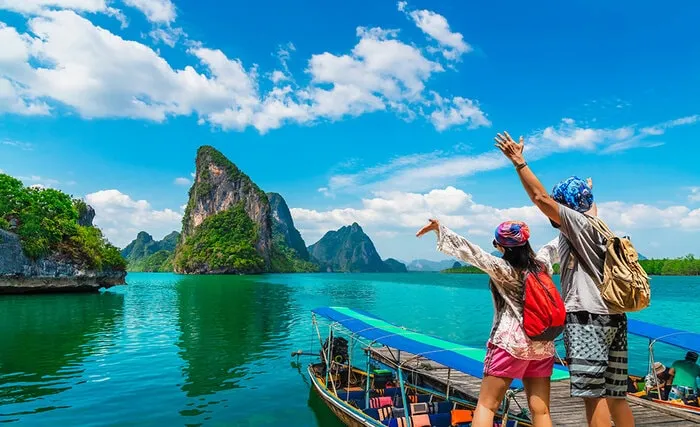
New e-visa issuance
On the morning of 24 June, the National Assembly approved a draft law amending and supplementing a number of articles on the law on entry and exit of Vietnamese citizens and the law on entry and exit, and transit of foreign visitors to Vietnam. The duration of an electronic visa (e-visa) will be increased from 30 days to 90 days. After being granted an electronic visa for 90 days, foreigners can enter and exit an unlimited number of times without having to go through new visa procedures. The law also allows citizens of countries that are unilaterally exempt from visas by Vietnam to temporarily stay for 45 days from a previous 15-day period and be considered for visa issuance and extended temporary residence as per new regulations.
Ms. Nguyễn Nguyệt Vân Khanh, marketing director of Vietravel, shared with Saigon Investment her views on this new visa policy saying that this visa will contribute greatly to improving Vietnam's competitiveness in the region in attracting international tourists, and will also create convenience in luring and attracting more international visitors to Vietnam than before. In addition, this is also a favorable condition for Vietravel to flexibly arrange a long-term travel schedule for international tourists to easily visit resort routes or explore the three Indochina countries of Vietnam-Laos-Cambodia, thereby increasing the spending budget of international tourists in Vietnam.
However, when talking about the impact of this visa policy, Mr. Phan Đình Huê, Director of Vietcircle Tourism Company, said that the new policy will not have an impact this year but will have a real impact in coming years. The reason is that this year, the world economic situation is still difficult, and tourists tend to save costs. In addition, the Russia-Ukraine conflict is significantly affecting the travel decisions of European tourists, one of the groups that Vietnam’s tourism industry aims to attract when the new visa policy takes effect.
According to Mr. Huê, the new visa policy will help bring in more tourists, but to have a more synchronous impact, Vietnam should expand the list of visa-exempt countries. Currently, Vietnam has exempted visas for citizens of 24 countries under unilateral and bilateral relations but there are limitations when entering Thailand, Malaysia, Indonesia, and Singapore. Some businesses also believe that it will not be until the 2024 tourist season at the earliest that the visa policy will really see the effects of growth in international tourism in Vietnam.
Shortcomings in tourism
The fact is that the new visa policy is only a necessary condition to attract tourists as it removes barriers for foreign guests to travel to Vietnam from far-off lands. But to really attract tourists to come, stay longer, and spend more, the story lies within the tourism industry. This is to say that the Vietnam tourism industry needs to have attractive products and improved services to compete with other destinations in the region. These are all inherent weaknesses within the tourism industry.
Mr. Phan Đình Huê emphasized that Vietnam has rich natural resources and is located in the center of Southeast Asia, but we lack products and services such as night products, entertainment products, shopping places, and dining places to serve a wide variety of tourists. Therefore, Vietnam must have a product development policy and an effective tourism promotion program as well.
Vietnam is still quite passive in promoting its image for tourism, especially in key markets. Even in the Chinese market, the main tourist market of Vietnam, we don't have a lot of promotional activities. The Southeast Asian market, or more broadly speaking, the Asian market, was Vietnam's main source of visitors in the first months of this year but the promotional activities in these markets were not really impressive.
Mr. Phan Đình Huê analyzing the story of promotion said that when the new visa policy takes effect, Vietnam can launch tours combining the three Indochina countries. At this point, we can consider a three-country, one-destination joint marketing plan to attract more tourists who often choose long-term tours. Along with the general picture of the tourism industry, each business also needs to make innovative efforts to take advantage of opportunities from the new visa policy.
Ms. Vân Khanh emphasized that the visa policy is both an important factor and a premise to create attractive destinations, but the attraction of international tourists is also based on many other factors such as diversified and new tourism products; attractive destinations; and enthusiastic and friendly service. These are core factors that Vietravel is focusing on building and developing in order to take full advantage of this new visa policy.
The latest report of the General Statistics Office shows that by the end of June, international visitors to Vietnam were estimated at nearly 5.6 million, 9.3 times higher than in the same period last year, but still only 65.7 percent compared to the same period in 2019, the year prior to the Covid-19 pandemic. In this, the Asian market is still the main tourist market with more than 4.1 million visitors entering Vietnam in the first six months of 2023. This year, the whole tourism industry aims to welcome 8 million international visitors, a rather modest number compared to other countries in the Southeast Asian region.




















